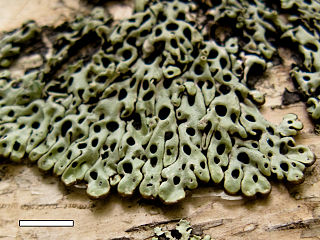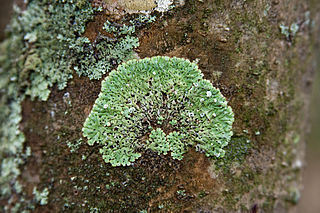
Parmelia is a genus of medium to large foliose lichens. It has a global distribution, extending from the Arctic to the Antarctic continent but concentrated in temperate regions. There are about 40 species in Parmelia. In recent decades, the once large genus Parmelia has been divided into a number of smaller genera according to thallus morphology and phylogenetic relatedness.

The Parmeliaceae is a large and diverse family of Lecanoromycetes. With over 2700 species in 71 genera, it is the largest family of lichen-forming fungi. The most speciose genera in the family are the well-known groups: Xanthoparmelia, Usnea, Parmotrema, and Hypotrachyna.

Hypogymnia is a genus of foliose lichens in the family Parmeliaceae. They are commonly known as tube lichens, bone lichens, or pillow lichens. Most species lack rhizines that are otherwise common in members of the Parmeliaceae, and have swollen lobes that are usually hollow. The lichens usually grow on the bark and wood of coniferous trees.

Myelochroa is a genus of foliose lichens in the family Parmeliaceae. They are commonly known as axil-bristle lichens. It was created in 1987 to contain species formerly placed in genus Parmelina that had a yellow-orange medulla due to the presence of secalonic acids. Characteristics of the genus include tightly attached thalli with narrow lobes, cilia on the axils, and a rhizinate black lower surface. Chemical characteristics are the production of zeorin and related triterpenoids in the medulla. Myelochroa contains about 30 species, most of which grow on bark. The genus has centres of distribution in Asia and North America.

Flavoparmelia is a genus of foliose lichens in the family Parmeliaceae. Because of their appearance, they are commonly known as greenshield lichens. The widely distributed genus contains 32 species. It was circumscribed by American lichenologist Mason Hale in 1986 to contain 17 former Pseudoparmelia species with broad lobes, usnic acid in the cortex, and isolichenan in the cell walls.

Canoparmelia is a genus of lichen-forming fungi in the family Parmeliaceae. The widespread genus contains about 35 species. Canoparmelia, a segregate of the parmelioid lichen genus Pseudoparmelia, was circumscribed by John Elix and Mason Hale in 1986.

Parmotrema is a genus of lichen belonging to the family Parmeliaceae. It is a large genus, containing an estimated 300 species, with a centre of diversity in subtropical regions of South America and the Pacific Islands.

Punctelia is a genus of foliose lichens belonging to the large family Parmeliaceae. The genus, which contains about 50 species, was segregated from genus Parmelia in 1982. Characteristics that define Punctelia include the presence of hook-like to thread-like conidia, simple rhizines, and point-like pseudocyphellae. It is this last feature that is alluded to in the vernacular names speckled shield lichens or speckleback lichens.

Xanthoparmelia is a genus of foliose lichen in the family Parmeliaceae. Xanthoparmelia is synonymous with Almbornia, Neofuscelia, Chondropsis, Namakwa, Paraparmelia, and Xanthomaculina. This genus of lichen is commonly found in the United States, as well as Australia, New Zealand and Ecuador.

Menegazzia is a genus of lichenized fungi containing roughly 70 accepted species. The group is sometimes referred to as the tree flutes, honeycombed lichens, or hole-punch lichens. The most obvious morphological feature of the genus is the distinctive perforations spread across the upper side of the thallus. This makes the group easy to recognise, even for those not particularly familiar with lichen identification.
Menegazzia capitata is a species of foliose lichen from Southeast Asia.
Menegazzia inactiva is a species of foliose lichen found in New Zealand and Australia. The type locality of this species is in Tasmania, south of Arthur River near Sumac Road. The species was discovered on Tasmannia lanceolata in rainforest habitat. The type specimen is held at the herbarium of the Tasmanian Museum and Art Gallery.
Menegazzia monospora is a species of foliose lichen from Southeast Asia.

Menegazzia pertransita is a species of foliose lichen in the large lichen family Parmeliaceae. It is found in New Zealand, Australia, and South America. The lichen was first formally described by Scottish physician and bryologist James Stirton in 1877 as Parmelia pertransita. Swedish lichenologist Rolf Santesson transferred it to the genus Menegazzia in 1942.

Menegazzia subsimilis is a species of lichen in the family Parmeliaceae It is found scattered across the world, including Oceania, Asia, Europe, South America, the Caribbean and North America. It has recently been recorded for the first times in Tibet (2005), in the British Isles, and in Malaysia and Indonesia (2007).
Menegazzia asekiensis is a species of foliose lichen in the family Parmeliaceae. It was first described in 2007 by John Elix, based on specimens found in Australia.
Parmotrema adspersum is a species of lichen in the family Parmeliaceae. It was originally described as a species of Parmelia by Edvard August Vainio in 1907. John Elix transferred it to Parmotrema in 2002, reasoning that its thick-walled ascospores are typical of that genus. Parmotrema adspersum is common in Thailand and the Philippines.
Xanthoparmelia klauskalbii is a species of foliose lichen in the family Parmeliaceae. Found in Australia, it was described as a new species in 2007 by John Alan Elix. It grows on weathered volcanic rocks. The specific epithet honours German lichenologist Klaus Kalb.
Menegazzia fortuita is a species of foliose lichen in the family Parmeliaceae. Found in Australia, it was described as a new species in 2017 by lichenologists John Elix and Patrick McCarthy. The type specimen was collected in Morton National Park where it was found in an open rocky ridge growing on sandstone. The specific epithet fortuita refers to its discovery: "an unplanned field-stop that led to the discovery of the most recent collection which, fortuitously, helped to resolve the identity of several older, unnamed specimens". The lichen is known to occur only in a few locations in Morton National Park where it grows on sandstone in open Eucalyptus woodland. The expected results for standard chemical spot tests are cortex K+ (yellow); medulla K+ (yellow), C–, KC–; P+ (yellow-orange). Menegazzia fortuita contains several secondary chemicals: stictic acid as a major component, atranorin and constictic acid as minor components, and trace amounts of peristictic acid, cryptostictic acid, and menegazziaic acid.










